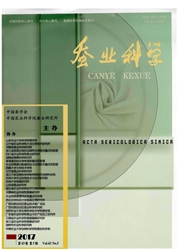

 中文摘要:
中文摘要:
给家蚕5龄幼虫分别添食大豆蛋白、NH4Cl和尿素后,调查家蚕产丝量的变化,并采用实时荧光定量PCR(qRT-PCR)方法检测蚕体丝腺组织中丝素重链基因(fib H)的表达变化,探究适合用于提高家蚕产丝量的含氮物质。5龄起蚕连续6 d按照0.45 mg/(头·d)的剂量添食尿素后,茧层率比对照组增加15.7%,且幼虫的体质量及丝腺体积都比对照组有所增加;5龄幼虫添食大豆蛋白和NH4Cl后茧层率无明显增加。qRT-PCR检测5龄起蚕按照上述剂量添食尿素120 h后,后部丝腺中fib H的表达量比对照组增加了1.5倍。上述结果再次证实了家蚕5龄幼虫添食尿素后可以增加产丝量,并且表明尿素可以促进蚕体后部丝腺中fib H基因的表达。
 英文摘要:
英文摘要:
To select the suitable nitrogen-containing nutrients to increase silk production,soy protein,NH4 Cl and urea were used as nutrient supplement for the fifth-instar silkworm( Bombyx mori) larvae. And then the silk production was investigated and the expression level of silk fibroin heavy chain gene( fib H) in silk gland was examined by real-time fluorescent quantitative PCR( qRT-PCR). The results showed that,compared to the control group,the cocoon shel rate was increased by 15. 7% and the body weight and the size of silk gland of the larvae were increased after the fifth-instar newly exuviated silkworm larvae were fed with urea at the dose of 0. 45 mg per larva and per day constinuously for 6 days. Nevertheless,soy proteins and NH4 Cl had no effect on the cocoon shel rate. The result of qRT-PCR showed that,compared to the control group,the expression level of fib H in posterior silk gland was increased by 1. 5 folds at 120 h after the fifth-instar newly exuviated silkworm larvae were fed with urea at the above dose. The above results confirmed that the administration of urea to the fifth-instar silkworm larvae could increase silk production and expression level of fib H gene in posterior silk gland.
 同期刊论文项目
同期刊论文项目
 同项目期刊论文
同项目期刊论文
 期刊信息
期刊信息
